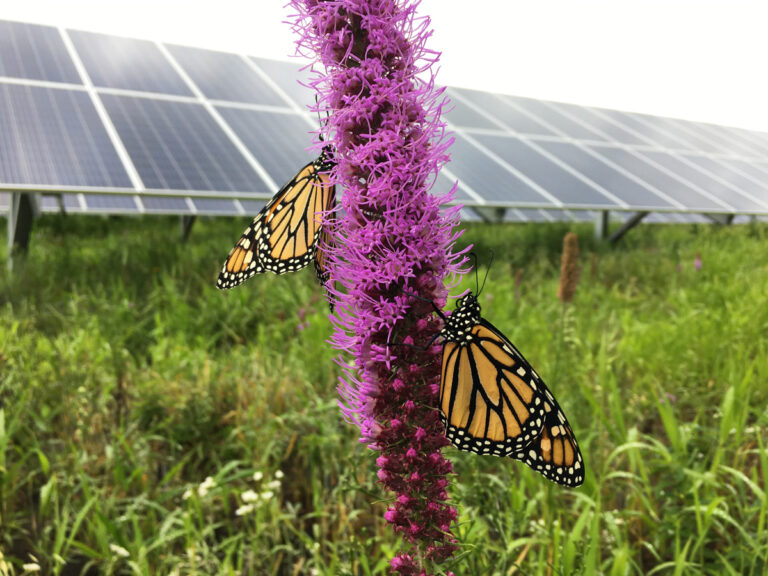Solar farms are expanding rapidly, with an estimated 6 million acres projected for solar energy production by 2050. However, conventional solar sites covered in gravel or turf offer little ecological value, increasing maintenance costs, soil degradation, and heat reflection.
These barren landscapes contribute to stormwater runoff, pollinator habitat loss, and localized temperature spikes that can even reduce solar panel efficiency. Without vegetation to stabilize soil and support biodiversity, solar farms risk becoming long-term environmental liabilities rather than truly sustainable solutions.
A better approach is integrating pollinator-friendly native plants, which support biodiversity, improve land stability, and enhance community support.
In this blog, we’ll break down how native seed mixes can transform solar sites into low-maintenance, ecologically rich landscapes.
The Downsides of Conventional Solar Energy Site Landscaping
Most large-scale solar farms rely on gravel or turf grass as ground cover beneath and around their panels. Developers often default to these solutions due to familiarity, regulatory expectations, and maintenance concerns, but in reality, they create long-term ecological and operational drawbacks.
Why Do Solar Energy Sites Use Gravel and Turf?
These choices are not made because they are the most sustainable but because they are perceived as the easiest and most cost-effective options:
- Perceived Low Maintenance: Gravel and turf seem like simple, manageable choices that require minimal upkeep compared to native vegetation.
- Fire Prevention: Many developers assume that short grass and bare gravel reduce fire hazards, particularly in dry regions.
- Regulatory Compliance: In many areas, local guidelines do not explicitly support pollinator-friendly alternatives, leading developers to stick with conventional choices.
The Downsides of Ecologically Unfriendly Solar Energy Sites
While these approaches may seem practical in the short term, they come with significant downsides:
- Higher Long-Term Maintenance Costs: Turf requires frequent mowing and irrigation, while gravel must be managed for weeds and erosion.
- Erosion and Stormwater Runoff: Without deep-rooted vegetation, soil degrades over time, leading to increased runoff and reduced groundwater absorption.
- Heat Reflection and Solar Efficiency Loss: Gravel and turf contribute to localized temperature spikes, which can reduce solar panel efficiency.
Taking the extra step to incorporate native vegetation may require more planning upfront, but it results in a solar farm that is more sustainable, cost-effective, and ecologically beneficial in the long run.
Why Pollinator-Friendly Solar Energy Sites Are the Better Choice
Transitioning from conventional gravel and turf to pollinator-friendly native vegetation offers solar developers an opportunity to create sites that are both ecologically beneficial and economically efficient.
Key benefits of pollinator-friendly solar energy sites include:
Lower Long-Term Maintenance Costs
Unlike turf, which requires constant mowing, or gravel, which demands weed management, native vegetation establishes itself naturally, minimizing upkeep over time.
Enhanced Biodiversity
A diverse mix of wildflowers and grasses supports pollinators, birds, and beneficial insects, fostering a healthier local ecosystem.
Stronger Soil and Water Conservation
Native plants have deep root systems that stabilize soil, reduce erosion, and enhance groundwater absorption, lowering the risk of stormwater runoff and soil degradation.
Enhanced Solar Panel Efficiency
A study in Environmental Science & Technology found that vegetation can lower surface temperatures around solar panels, preventing efficiency losses from heat buildup.
Increased Community Support
Research from the National Renewable Energy Laboratory (NREL) indicates that communities are more likely to approve solar projects when they provide ecological benefits.
By rethinking conventional landscaping choices, solar developers can create projects that generate clean energy without sacrificing ecological integrity—a long-term win for sustainability, cost savings, and public perception.
How to Implement a Pollinator-Friendly Solar Energy Site
Switching from conventional turf or gravel to native vegetation requires thoughtful planning, but the long-term benefits far outweigh the initial investment. Here’s how solar developers and landowners can successfully transition to a more sustainable approach.
1. Assess the Site and Set Goals
Before selecting plant species, it’s essential to evaluate site conditions and project objectives:
- Soil Type: Understanding soil composition helps determine which native plants will thrive.
- Climate and Weather Patterns: Consider seasonal conditions and long-term climate trends.
- Local Pollinator Species: Identify key pollinators in the region to select plants that best support them.
- Land Use Goals: Define whether the site should focus on erosion control, water conservation, or maximizing pollinator habitat.
2. Prepare the Land for Planting
Establishing native vegetation requires proper site preparation to prevent competition from invasive plants and ensure healthy root establishment. Key steps include:
- Removing Existing Vegetation: Turf or weedy growth should be cleared using mowing, herbicide, or solarization.
- Minimizing Soil Disturbance: Excessive grading can disrupt soil structure and reduce plant success.
- Applying a Temporary Cover Crop (if needed): This helps control erosion and improve soil quality before native seeding.
3. Plant at the Right Time
Timing is crucial for seed germination and plant establishment. In most regions:
- Fall Planting is preferred for cold-stratification species like milkweed, allowing seeds to break dormancy naturally.
- Spring Planting works well for warm-season grasses and wildflowers that require soil warmth to germinate.
4. Maintain and Monitor the Habitat
Once established, pollinator-friendly solar farms require less ongoing maintenance than turf or gravel but still benefit from periodic care:
- Weed Management: Native plantings outcompete weeds over time, but occasional control may be necessary in the early years.
- Mowing and Trimming: Seasonal mowing (once or twice a year) helps maintain plant diversity and prevent woody overgrowth.
- Long-Term Monitoring: Regular site assessments ensure plant health and identify any areas needing reseeding or management adjustments.
By following these steps, solar developers can create thriving, low-maintenance pollinator habitats that enhance biodiversity, improve land sustainability, and maximize the efficiency of their solar installations.
Best Native Plants for Pollinator-Friendly Solar Energy Sites
The best species are those that thrive in local conditions, require minimal maintenance, and provide sustained benefits for pollinators and soil health.
Recommended Plant Types
Perennial wildflowers, native grasses, and ground cover plants can all be very beneficial when establishing a pollinator-friendly solar energy site:
Perennial Wildflowers
These provide long-lasting forage for bees, butterflies, and other pollinators:
- Black-eyed Susan (Rudbeckia hirta): Drought-tolerant and supports a wide range of pollinators.
- Butterfly Milkweed (Asclepias tuberosa): Essential for monarch butterflies.
- Purple Coneflower (Echinacea purpurea): A valuable nectar source for bees.
Native Grasses
Native grasses like these can improve soil structure, prevent erosion, and add habitat diversity:
- Little Bluestem (Schizachyrium scoparium): Thrives in various soil types and stabilizes the ground.
- Switchgrass (Panicum virgatum): Deep roots improve soil quality and carbon storage.
- Sideoats Grama (Bouteloua curtipendula): Provides cover and food for pollinators.
Ground Covers
Improve soil structure, prevent erosion, add habitat diversity, and can be especially useful during the establishment of a new site:
- Star Sedge (Carex intumescens): A hardy, shade-tolerant ground cover that requires minimal maintenance.
- Phlox (Phlox spp.): Forms a mat-like cover, attracting butterflies and serving as an excellent weed suppressant.
For the best results, it’s important to choose seed mixes specifically designed for solar sites, which provide the right balance of wildflowers, grasses, and ground covers for long-term success.
Create a Sustainable Solar Energy Site with Ernst Seeds
Transitioning to pollinator-friendly solar energy sites is one of the most effective ways to enhance the sustainability of solar energy. By replacing gravel and turf with native vegetation, developers can improve biodiversity, strengthen soil health, reduce maintenance costs, and even increase solar panel efficiency.
With proper planning and the right plant selections, solar farms can become valuable conservation spaces rather than just energy production sites. To help make this vision a reality, Ernst Conservation Seeds offers a range of high-quality native seed mixes tailored for solar farms, helping landowners and developers create truly sustainable projects.
If you’ve got questions we didn’t answer, the experts at Ernst are ready to help. Contact us today and let us know what you need.

